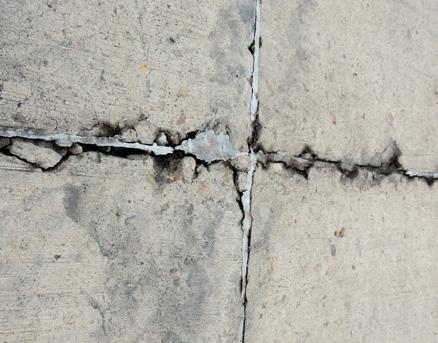
2 minute read
Prompt attention to spalled joints helps prevent costly repairs
by 3S Media
Spalling occurs due to cracking, breaking or chipping in the immediate vicinity of joints, usually within 100 mm of the joint. “A spall usually does not extend vertically through the slab, but extends to intersect the joint at an angle,” Perrie explains. Common contributing factors include: - excessive stress at the joint, caused by the accumulation of incompressible material in the joint and subsequent expansion of adjoining slabs in concrete pavements - weak concrete at the joint - poorly designed or constructed loadtransfer devices or failure of such devices - poorly constructed joints. “Early repair of spalling is needed to improve serviceability, deter further deterioration, and provide proper edges so that the joints can be resealed effectively,” Perrie advises. “Before any repairs are carried out, it should be determined if the spalling is due to a loss of load transfer at the joints.”
Sounding technique
Advertisement
If there is adequate load transfer at the joints, all areas of delamination should be determined using a ‘sounding technique’ by striking the existing concrete surface with a steel rod or by tapping lightly with a hammer. A sharp metallic ring will indicate undamaged concrete, while a dull or hollow sound will indicate delaminated areas.
“The area around the perimeter of the patch area should be sawn down with a concrete saw to a minimum depth of 35 mm to provide a vertical face at the patch edges and provide sufficient depth to give integrity to the patch. Additional cuts in the joint to a depth of 25 mm below the bottom of the patch – and extending at least 75 mm laterally beyond each end of the prepared patch boundaries – should then be sawn,” Perrie explains.
The concrete inside the patch area should be exposed to at least 35 mm deep with a hammer and sharp cold chisel or light pneumatic tool until sound and clean concrete is exposed and the patch area is uniform in thickness.
“It is important that tools of the appropriate size are used. Using a pneumatic hammer – which is too large – will cause damage and fracture the concrete below. Under no circumstances should heavy jack hammering be used,” Perrie cautions.
Spalling of joints in concrete floors should be regarded as an early warning of more serious potential long-term damage. However, the size and cost of repairs can be reduced if the damage is detected and repaired at an early stage, says
Bryan Perrie,
CEO of Cement & Concrete SA (CCSA).
Bryan Perrie, CEO of Cement & Concrete SA
Joint filler and epoxy resin
When all partially loose concrete has been removed, a bond-breaking compressible joint filler (such as expanded polystyrene foam) should be inserted into the existing joint against the existing slab to fill the saw cut. Then a wet-to-dry epoxy resin should be applied as bonding agent to the entire area, including patch sides. Perrie adds that in larger patches, consideration should also be given to the use of mechanical anchors.
Opening to traffic
Following on from this, the hole should then be patched with a concrete designed by an approved concrete testing laboratory to suit the aggregates available and the desired time of opening to traffic.
“The required minimum compressive strengths are 30 MPa for vehicles with pneumatic tyres, and 40 MPa for vehicles with solid tyres. The recommended minimum strengths should be achieved with a cement content not exceeding 500 kg/m3. A water reducer may be










